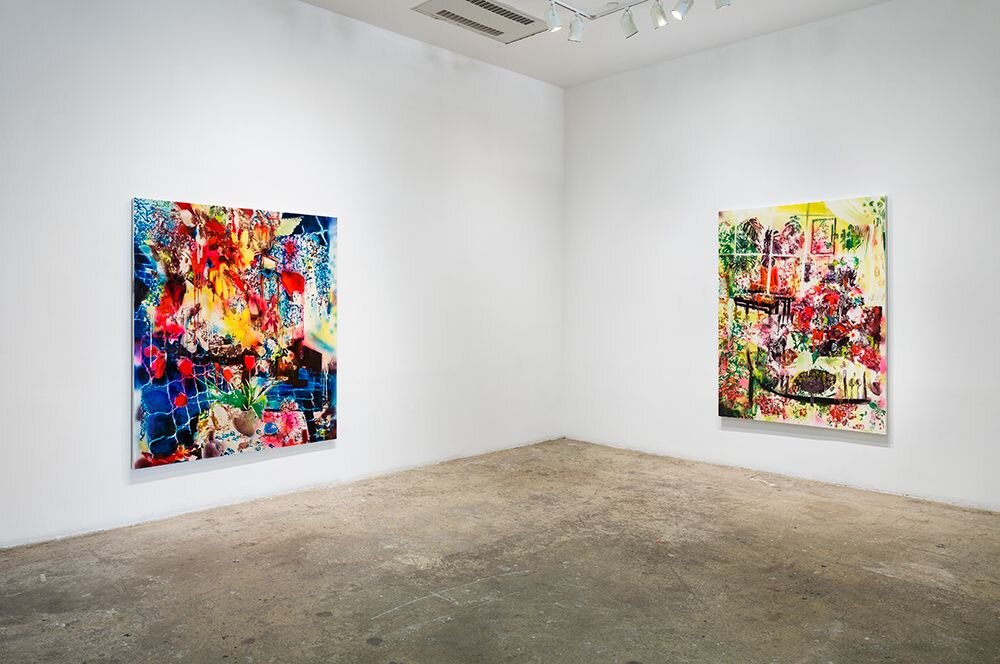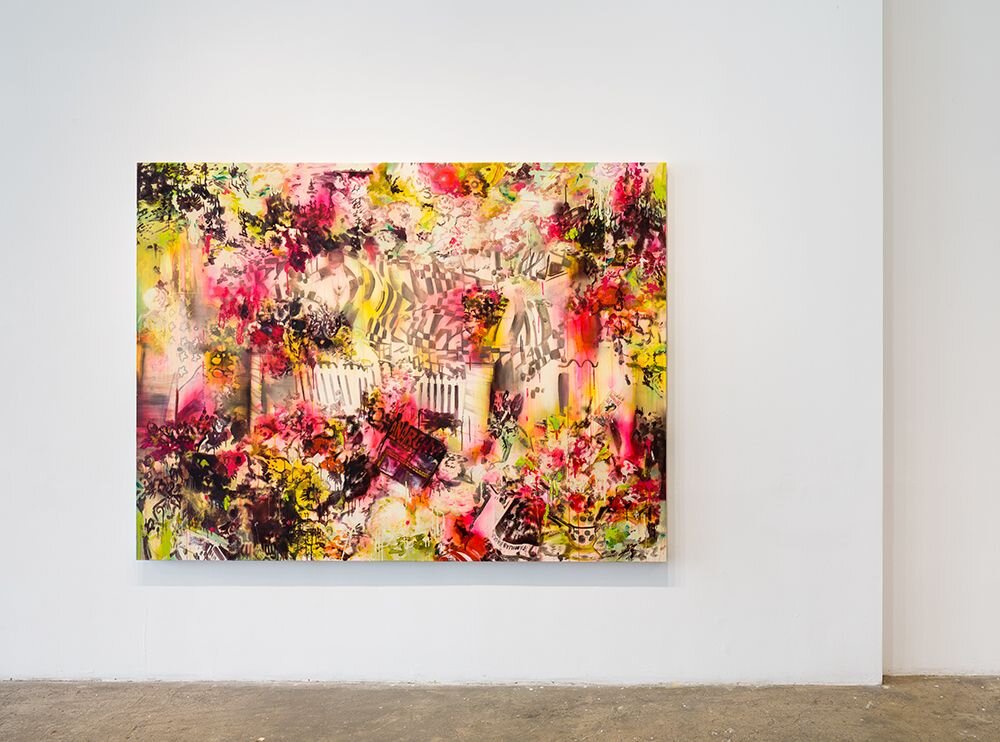Rosson Crow | HYSTERIA: Spatial Conversations with Florine Stettheimer
April 22 – May 17, 2015
Rosson Crow | HYSTERIA: Spatial Conversations with Florine Stettheimer
April 22 – May 17, 2015
Sargent’s Daughters is pleased to present “HYSTERIA: Spatial Conversations with Florine Stettheimer”, an exhibition of five new paintings by Los Angeles based artist Rosson Crow. In this recent body of work, Crow debuts a new technique of Xerox transfers layered with painting on the canvases. This will be Crow’s first solo exhibition in New York since 2010 and her first collaboration with the gallery.
Rosson Crow has long been fascinated by history and the psychology of interior spaces, and has addressed subjects as varied as French Revolutionary interiors, New York City graffiti and the films of Alfred Hitchcock. This exhibition represents Crow's response to the paintings of Florine Stettheimer (1871-1944), a New York artist whose paintings date from the 1910s to the 1940s. Although considered a very important artist of her time, (Marcel Duchamp organized her retrospective exhibition at MOMA in 1946, and she was included in the first Whitney Biennale in 1932) Stettheimer's works are relatively unknown today as she steadfastly refused to sell or show them in galleries. Since her death, they have often been dismissed as overly "feminine" and "eccentric” and today Stettheimer remains known mostly to a growing cult of women artists on both sides of the Atlantic who love and claim her influence.
In Stettheimer’s poetry, she often described the art world as a "men's club” and she was largely confined in terms of subject matter to painting domestic scenes of her family and the leisure pursuits of friends who were members of the wealthy New York art avant-garde. Crow is also drawn to the idea of domestic interiors traditionally considered a “feminine" space and is, like Stettheimer, unconcerned with precedents. Both artists have evolved their own manner and style of painting that is quite distinct from that of their contemporaries, as well as turning their interests to the theatrical. Stettheimer spent a significant period of her early life in Europe, and incorporated European art historical traditions into her early work before abandoning them upon her return to New York. Similarly, Crow’s references to the European academy inform her work even while she eschews it for a distinctly American flamboyance.
The title “HYSTERIA” is a tongue-in-cheek reference to medical terminology that consigned all female maladies to this “psychological disorder” that only affected women. Crow references this as a catch-all term to dismiss women and the spaces that women inhabit as inferior, as well as the implication of something chaotic and wild that needs to be controlled. Stettheimer’s beloved Aunt Josephine, the first woman medical intern in America, studied with the French neurologist Dr. Jean Martin Charcot, who believed that domestic interiors reflected the psychology of those who lived inside.
Actual interior space was vitally important to Stettheimer, who created elaborate designs for her studio to enhance and compliment her artistic world. Crow, too, creates a world within her works that is highly theatrical. Crow studied acting and Stettheimer designed several theatrical settings for avant-garde productions and the compositions of both artists' paintings reflect this. They are tilted forward towards the viewer, the space constructed with a very high, often invisible, horizon line. This cross-pollination of artistic worlds allows for a freedom that both elevates and separates Crow and Stettheimer’s works.
In Stettheimer’s paintings, friends and family move and are staged across the canvases as though participating in a story line, often appearing several times within a single composition. Crow's paintings are unpopulated. Instead they are colored, densely patterned stage sets, as though waiting for actors to enter so the performances can begin. But at the same time, every discrete element appears to be melting in paint drips down the surface. This gives the whole a sense of anxiety, of imminent disaster.
The richly drenched canvases and interior imagery that Crow spreads across her large canvases are haunting, contemporary, interpretations of Stettheimer's decorative, feminine, domestic scenes, sharing in some of the bright jewel-toned colors of Stettheimer’s work. In Crow’s “Ocular Maze Work”, elements of Stettheimer's “Studio Party, or Soiree” (1917-19) are compressed and appear to float in the overgrown interior. In Stettheimer’s “Flowers Against Wallpaper” (1915), Stettheimer positions real flowers against a floral patterned wallpaper, creating an optical illusion and humorous question of what is the “real” flower. Crow’s use of the Xerox transfer florals employs a similar visual sleight-of-hand by patterning the flowers she paints against the ghost-image of the Xerox transfer. After hand collaging, Crow enlarges the collages and photo-transfers them to the surface of the canvas, where an imprint of the original remains. Subsequent layers of spray paint, acrylic and then oil paint are then added. Both artists often fill works with abundant flora, vegetation, and elements of rococo, or sinuously stylized, furnishings. As with Stettheimer's work, Crow's paintings initially convey a romantic nostalgia. Yet hidden in each artist’s compositions are details evidencing often biting, ironic, wit.
Crow's paintings explore constructed space from a decidedly contemporary point of view. Stettheimer subversively used humor within decoratively feminine spaces to make fun of her surroundings and her cossetted lifestyle, using her immediate environment to create her own startlingly unique painting style and subject matter. Almost a century later, Rosson Crow's highly feminized, decorative, experiential spaces are charged reflections of contemporary life as a period of decadence. Crow embraces a theatrical interpretation of Stettheimer’s defining domesticity and allows it a fresh life in the exterior, as well as interior, world.
Press release written in collaboration with Barbara Bloemink.
Rosson Crow (b. 1982 Dallas, TX) lives and works in Los Angeles. She received her MFA from Yale University, and a BFA from the School of Visual Arts in New York. Solo museum exhibitions include Rosson Crow at the Musée Régional d'Art Contemporain de Sérignan, France (2014); Myth of the American Motorcycle at the Contemporary Arts Center, Cincinnati, OH (2010) and FOCUS: Rosson Crow at the Modern Art Museum of Fort Worth, TX (2009). Crow has been included in exhibitions in museums internationally such as the Royal Academy of Arts, London, The Andy Warhol Museum, Pittsburg, PA, Musee d'Art Moderne Grand-Duc Jean, Luxembourg and The Macro Future Museum, Rome, IT. Solo gallery exhibitions include: Galerie Nathalie Obadia, Paris, FR (2013); Honor Fraser, Los Angeles, CA (2012); Deitch Projects, New York, NY (2010); and White Cube, London, UK (2009).





